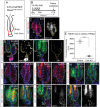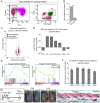Polycomb repressive complex 2 in adult hair follicle stem cells is dispensable for hair regeneration
- PMID: 34905545
- PMCID: PMC8670713
- DOI: 10.1371/journal.pgen.1009948
Polycomb repressive complex 2 in adult hair follicle stem cells is dispensable for hair regeneration
Abstract
Hair follicle stem cells (HFSCs) are multipotent cells that cycle through quiescence and activation to continuously fuel the production of hair follicles. Prior genome mapping studies had shown that tri-methylation of histone H3 at lysine 27 (H3K27me3), the chromatin mark mediated by Polycomb Repressive Complex 2 (PRC2), is dynamic between quiescent and activated HFSCs, suggesting that transcriptional changes associated with H3K27me3 might be critical for proper HFSC function. However, functional in vivo studies elucidating the role of PRC2 in adult HFSCs are lacking. In this study, by using in vivo loss-of-function studies we show that, surprisingly, PRC2 plays a non-instructive role in adult HFSCs and loss of PRC2 in HFSCs does not lead to loss of HFSC quiescence or changes in cell identity. Interestingly, RNA-seq and immunofluorescence analyses of PRC2-null quiescent HFSCs revealed upregulation of genes associated with activated state of HFSCs. Altogether, our findings show that transcriptional program under PRC2 regulation is dispensable for maintaining HFSC quiescence and hair regeneration.
Conflict of interest statement
The authors have declared that no competing interests exist.
Figures



Similar articles
-
Signalling couples hair follicle stem cell quiescence with reduced histone H3 K4/K9/K27me3 for proper tissue homeostasis.Nat Commun. 2016 Apr 15;7:11278. doi: 10.1038/ncomms11278. Nat Commun. 2016. PMID: 27080563 Free PMC article.
-
Cell Types Promoting Goosebumps Form a Niche to Regulate Hair Follicle Stem Cells.Cell. 2020 Aug 6;182(3):578-593.e19. doi: 10.1016/j.cell.2020.06.031. Epub 2020 Jul 16. Cell. 2020. PMID: 32679029 Free PMC article.
-
Smad1 and 5 but not Smad8 establish stem cell quiescence which is critical to transform the premature hair follicle during morphogenesis toward the postnatal state.Stem Cells. 2014 Feb;32(2):534-47. doi: 10.1002/stem.1548. Stem Cells. 2014. PMID: 24023003 Free PMC article.
-
Not just a writer: PRC2 as a chromatin reader.Biochem Soc Trans. 2021 Jun 30;49(3):1159-1170. doi: 10.1042/BST20200728. Biochem Soc Trans. 2021. PMID: 34060617 Free PMC article. Review.
-
Hair follicle stem cells as a skin-organizing signaling center during adult homeostasis.EMBO J. 2021 Jun 1;40(11):e107135. doi: 10.15252/embj.2020107135. Epub 2021 Apr 20. EMBO J. 2021. PMID: 33880808 Free PMC article. Review.
Cited by
-
Epigenetic regulation of embryonic ectoderm development in stem cell differentiation and transformation during ontogenesis.Cell Prolif. 2023 Apr;56(4):e13413. doi: 10.1111/cpr.13413. Epub 2023 Feb 1. Cell Prolif. 2023. PMID: 36727213 Free PMC article. Review.
-
Polycomb Directed Cell Fate Decisions in Development and Cancer.Epigenomes. 2022 Sep 6;6(3):28. doi: 10.3390/epigenomes6030028. Epigenomes. 2022. PMID: 36135315 Free PMC article. Review.
-
Overview of chromatin regulatory processes during surface ectodermal development and homeostasis.Dev Biol. 2024 Nov;515:30-45. doi: 10.1016/j.ydbio.2024.07.001. Epub 2024 Jul 4. Dev Biol. 2024. PMID: 38971398 Review.
-
Polycomb repressive complex 2 regulates basal cell fate during adult olfactory neurogenesis.Stem Cell Reports. 2023 Nov 14;18(11):2283-2296. doi: 10.1016/j.stemcr.2023.09.008. Epub 2023 Oct 12. Stem Cell Reports. 2023. PMID: 37832538 Free PMC article.
References
Publication types
MeSH terms
Substances
Grants and funding
LinkOut - more resources
Full Text Sources
Molecular Biology Databases

